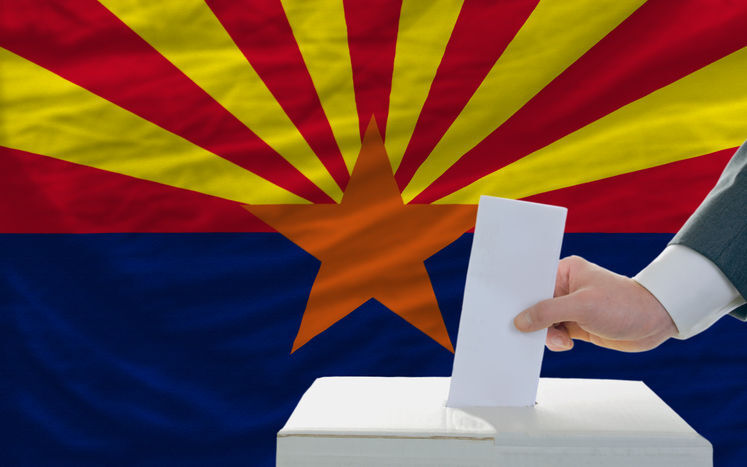A change in federal election laws and a quirk in the 2024 calendar are creating problems for state and county election officials.
Unless those are resolved, the worst-case scenario is that, in a race for president as close in Arizona as the one in 2020, voters here could lose their voice in deciding who will be in the White House.
The problem begins with Congress’ decision to amend the Electoral Count Act, according to Jennifer Marson, lobbyist for the Arizona Association of Counties.
That 1887 law set up the procedures under which Congress would tally the electoral votes from each state to determine who was elected.
But provisions of it came under scrutiny after the 2020 election, when competing slates of electors claimed they were the rightful picks in some states including Arizona. Changes were made to ensure it is the governor who sends the slate, that expedited judicial review is provided, and that it takes more members of Congress than before to challenge a state’s electoral count.
The law now also clarifies that the vice president’s role is only administrative, without the power to reject disputes over electors. Then-President Donald Trump had tried to get his vice president, Mike Pence, to disregard the 2020 electoral tally.
What it also does, however, is provide a hard-and-fast deadline for states to get their formal results to Congress to have them considered. Next year the calendar has that fall on Dec. 11, Marson said.
That’s not a problem if there are no disputes, as the formal state canvass of the vote is set for Dec. 2.
But if there’s a recount ordered in the presidential race, that can’t begin until after the canvass, which itself can’t be done until each county has canvassed the votes. Marson said election officials who are looking at the problem have concluded that, under current laws, that would drag out long past the Dec. 11 deadline.
That deadline wasn’t as much of a problem in prior years.
The U.S. Supreme Court had provided a “safe harbor,’’ giving states a bit more time to conduct their post-election activities despite the statutory deadline as long as they got the process done at least six days before the Electoral College meets.
But with that safe harbor provision gone, Marson said the law can be read that electoral votes not finalized and transmitted by Dec. 11 simply might not be counted.
And here’s the other factor.
Joe Biden defeated Trump in Arizona in 2020 by 10,457 votes, winning the state’s 11 electoral votes. That’s a 0.3% difference.
But a 2022 Arizona law increased the margin for automatic recounts to 0.5%. So a race in 2024 as close as the one in 2020 would trigger a recount — and create the deadline problems.
That worry is enough that it has gotten the attention of county recorders and Secretary of State Adrian Fontes, who is the state’s chief election official.
“We want to make sure it doesn’t negatively affect any of our voters,’’ said Fontes’ press aide Paul Smith-Leonard. “And we want to make sure Arizona’s voice is heard in the next election.’’
He said that’s going to require some changes in state law. That means getting not just the buy-in of elected officials and lawmakers statewide, and from both parties, but also the consent of Gov. Katie Hobbs.
Marson said there are just too many legal hoops to be jumped through in too little time.
Any recount cannot start until the canvass and counties can’t even begin the process on their own but have to wait for a court order, she said.
The good news is that a recount doesn’t involve a hand count. Instead, the ballots are fed back through the same tabulators.
But Marson said current law requires a new “logic and accuracy test’’ of the tabulators, a process in which ballots are fed through the machine to ensure what is reported matches the known results. The Secretary of State’s Office has to send teams to each of the 15 counties to conduct that test.
Then the results from all the counties are sent to a judge who would unseal them, something that might not happen until after Christmas under the current timeline.
So what to do? “There’s no single solution,’’ Marson said. Instead, she said, it’s going to come down to a series of smaller changes to the law, each of which could pick up a few days.
That could start right after the general election.
Current law provides up to five days for those whose signatures do not match to “cure’’ them by contacting local election officials.
Marson said this has been interpreted to mean five “business days,’’ meaning weekends do not count. If the law is changed to spell out those are “calendar days,’’ that picks up two days right there.
Moving up the deadline for counties to conduct their own canvasses also could save up to eight days, including the change to the cure period.
What also would help, she said, is allowing counties to conduct their own logic and accuracy tests, without having to wait for state officials.
And the state could shorten the period to file legal challenges to election results to three days after the canvass, down from five.
That, however, could prove politically difficult as some of the losing candidates who challenged the 2022 returns have complained that the window already is too small.
Get your morning recap of today's local news and read the full stories here: tucne.ws/morning.





